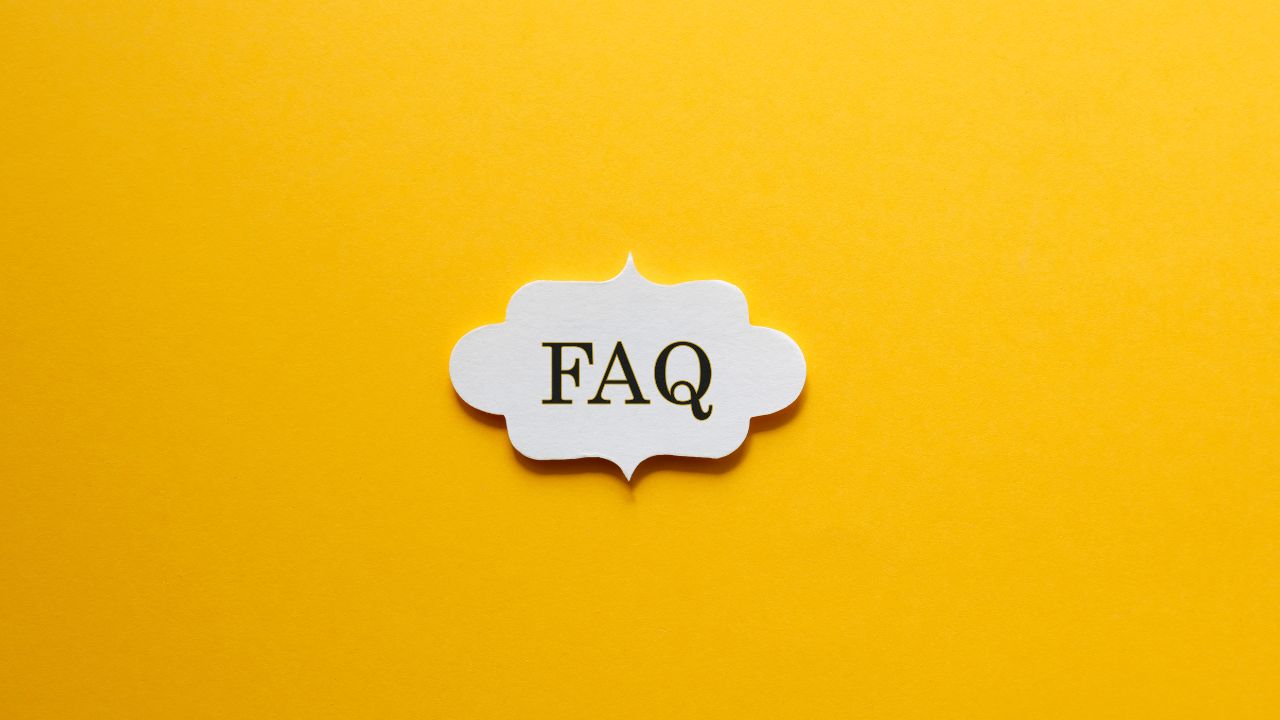Behaviors as a lever for reliable and sustainable organic growth

Indice
“Growth is never by mere chance; it is the result of forces working together.”
James Cash Penney, JC Penney founder
Growing the company has always been a central theme on the agenda of every CEO and, in the current economic and competitive context characterized by high unpredictability and uncertainty, ensuring economic and human sustainability in the company can be enormously complicated.
If we define “Business Growth” as an increase in the company’s value, which can include an increase in market share, an acceleration in market penetration or the acquisition of certain intellectual property crucial to one’s business, the traditional approach to growth focuses primarily on product differentiation and therefore on marketing activities to convey this differentiation to the market. However, numerous examples show that an effectively differentiated and qualitatively superior product does not always win over the customer.
In fact, if we look at the Customer Decision Journey, the different actions and behaviors that a specific customer performs along a common path can be strongly different from person to person. There are many variables, even seemingly trivial, that can influence the choice path and lead to a different purchase decision.
For this reason, a different approach to business growth is needed, which addresses the possible uncertainties along the customer decision path, so that specific actions and behaviors are a guided path that leads customers to our offer.
By identifying and focusing on 1 or 2 “high-performance” customer behaviors and guiding customer behaviors at critical points in the purchase journey (aiming to move them to paths more favorable to our offer), companies can achieve faster and more reliable sales growth with less effort.
The methodological steps that develop this different approach and help to focus on the behaviors of the customers that we would like to guide and modify to increase the chances that our offer is purchased are as follows:
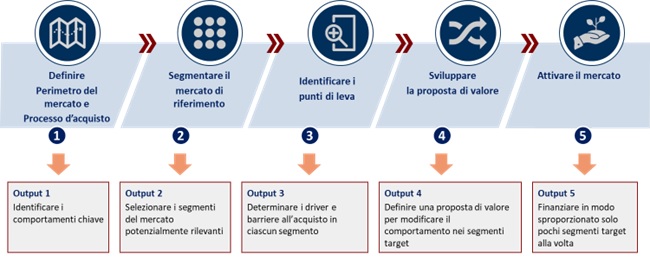
- STEP 1 – Define the market perimeter and the purchasing process
- STEP 2 – Segment the reference market
- STEP 3 – Identify the leverage points
- STEP 4 – Develop the value proposition
- STEP 5 – Activate the market
Each step calls for clear instrumental outputs with which to make key decisions on where and how to grow:
- OUTPUT 1 – Identify key behaviors
- OUTPUT 2 – Select potentially relevant market segments
- OUTPUT 3 – Determine the drivers and barriers to purchase in each segment
- OUTPUT 4 – Define a value proposition to guide behavior in target segments
- OUTPUT 5 – Selectively finance only a few target segments, a few at a time
Effective commercial actions and new markets: a real application case
This methodological approach was used in a project with a Lenovys customer, a manufacturer of water purification plants.
Within the 15–30-million-euro turnover class, with an international customer portfolio, for some years it had been experiencing slow growth in revenues and number of customers, despite excellent business opportunities in overseas markets, particularly in Latin America.
Define the market perimeter and outline the purchasing process
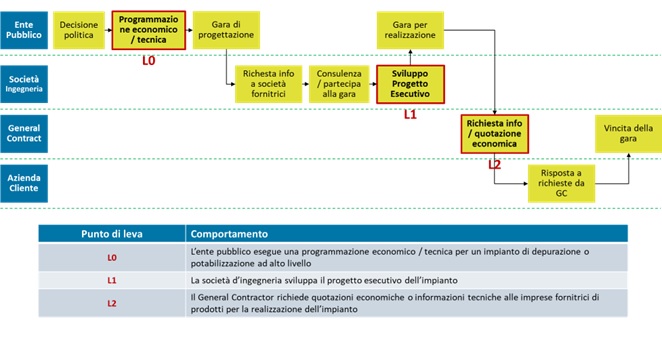
As a first step, to optimally set the growth strategy, the customer purchasing process was outlined within the geographical reference perimeter, identifying the behaviors on which the company could leverage to effectively stimulate and encourage customer purchasing behaviors.
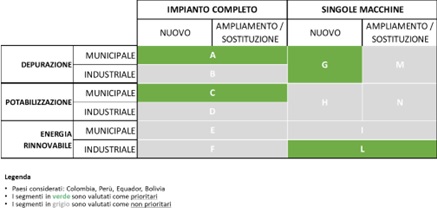
Thanks to the overall vision of the behavior of all the players on the market, and to the identification of the behaviors on which the company can work to increase the probability of increasing the sales of its purification plants, Lenovys has developed market segmentation and identified the segments considered priorities for subsequent commercial actions.
Specifically, a basket of Latin American countries was examined.
Segment the target market
In more general terms, to construct the segmentation framework it is important to define variables based on two attributes:
- the operability of the variable, that is the possibility of the company performing commercial actions
- The significance, that is the ability of the variable to explain the purchasing behavior of the different actors identified in the purchase process mapped in the previous point.
In the project that Lenovys conducted with the client, the specific vertical market of origin of the different clients (water purification, potabilization of water and use of products for purification in the plants of creation of Energy) and the different customer purchasing needs (complete sewage treatment plants or add-ons with individual machines) were evaluated and considered as strategic variables to effectively analyze the market.
Then, for each prioritized segment, we built the Customer Portrait.
The customer portrait: a map to define drivers and barriers to purchase
To state what experience is desired by that segment in the purchase and use of the products offered and to understand which the drivers and barriers are to purchase that characterize the specific purchasing process for the segment under consideration is instrumental in identifying actions of the most suitable commercial options that the company can then put into practice through the various channels available to it.
Developed the Customer Portrait (find out here how to draw the customer portrait) for each market segment you need to determine its value proposition, which will be drawn specifically for each prioritized segment.
Develop the value proposition
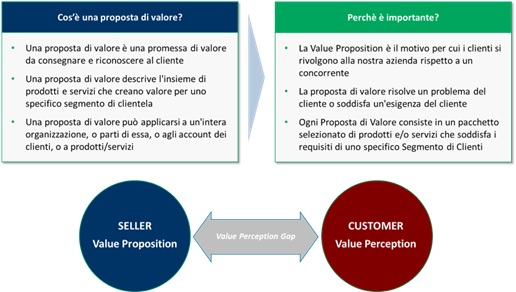
The value proposition does not focus solely on the validity of the product offered, emphasizing its technical qualities, but is developed considering the drivers and purchasing barriers of the segment considered, aiming to influence the leverage behaviors identified in the previously mapped purchasing process.
As an example, the value proposal for segment A (Purification, complete plant) is reported.
Read here a detailed article on the development of a value proposition
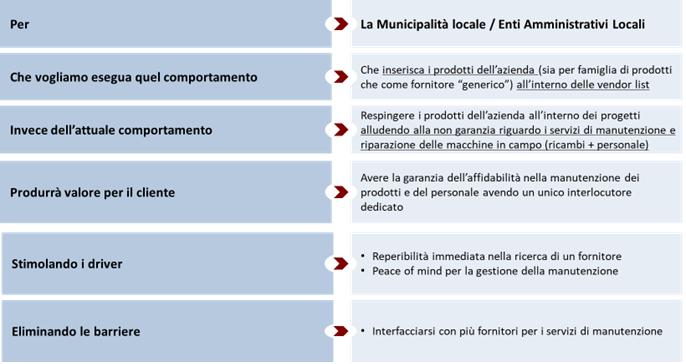
The last step requires the development of a specific market activation plan for each segment, that is, the initiation of all those commercial actions (and non-commercial but internal to the company, such as an organizational change or a process review) Useful to stimulate key behaviors identified that are functional to increase the company’s revenues.
For business actions to be effective, there is then a need for a significant change in the company’s spending habits, this final phase involves a disciplined and systematic approach to conducting behavioral change campaigns in sequence and segment specific.
The content of the market activation plans differs by segment and by company reality, being peculiar to the customers considered and the GAP that the company suffers. For each market plan, therefore, it is important to outline actions, potential impact, dedicated resources, timing and owner of each action to be completed.
The results of the project
The company’s results accumulated in the months following the development of the market activation plans were aligned with the set growth targets and have led to a differentiated increase in revenues in the different target Countries and stimulated organizational improvement plans within the business structure.
Focusing on the behaviors that different market players perform throughout the purchasing process and how we can direct these behaviors towards the purchase of our commercial offer can make a difference in achieving sustainable growth paths and repeatable.
Focusing solely on the product as such, its characteristics and differentiation from competing offers can lead to sterile and inefficient growth paths that are not economically sustainable (for the amount of resources required, for the time, for the ease with which during the whole life of a product the possibility to lose the uniqueness of the Unique Selling Proposition relative to the individual products grows.)
Articolo a cura di:

Riccardo Siciliani
former Manager Lenovys
He is a Manager in the Delivery Unit Strategy & Innovation at Lenovys, and manages projects related to the definition and implementation of corporate strategies, the innovation systems and application of Lean Product and Process Development principles with clients operating in the manufacturing, food & beverage and financial services sectors.
Read more
Prossimi eventi






